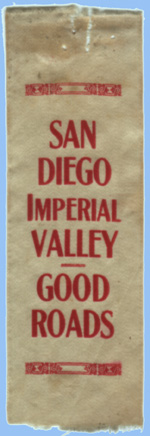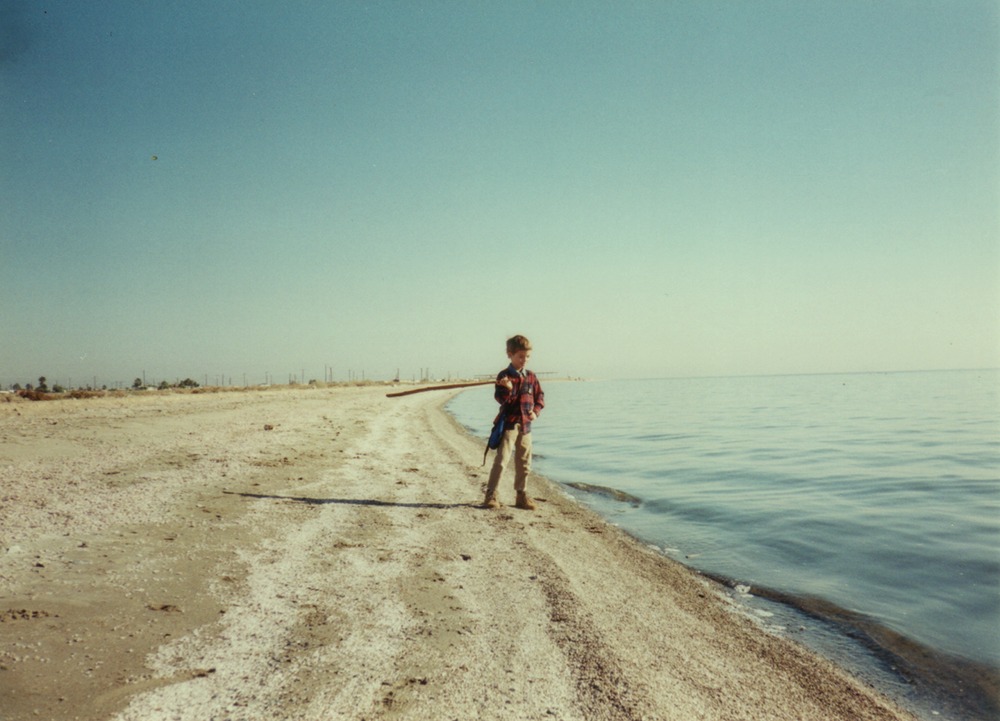Water Is for Washing
by Robert A. Heinlein
Argosy, November 1947
collected in —
The Menace from Earth
Flash flood in a desert valley
Disaster stories based on floods have been a favorite for many centuries. Robert A. Heinlein's short story "Water Is for Washing" is a miniature specimen of the type. This story packs a neater punch than many whole novels of natural disasters and human reactions to them. It is included in Heinlein's collection The Menace from Earth. Whether you call "Water Is for Washing" science fiction may depend on what you appreciate of the great dry basin of desert hollowed below sea level, the long low center of the Imperial Valley in southeastern California.
Heinlein opens thusly:
He judged that the Valley was hotter than usual — but, then, it usually was. Imperial Valley was a natural hothouse, two hundred and fifty feet below sea level, diked from the Pacific Ocean by the mountains back of San Diego, protected from the Gulf of Baja California by high ground on the south. On the east, the Chocolate Mountains walled off the rushing Colorado River.
A major flood is a nightmarish situation to be caught in, with human responses often dramatic and heroic; hence our long racial fascination with floods. Heinlein's fellow Missourian, Mark Twain, writes of exploring by steamboat a vast flood along the lower Mississippi River in Life on the Mississippi. The Imperial Valley has its own local memory of a great desert flood, when the Colorado River went through its banks in 1905. The river rushed down into the lowest areas of the Imperial Valley basin, creating the Salton Sea — California's largest lake, whose surface is more than 200 feet below sea level. It's the water in the bottom of the pan, but there's still a lot of room down in the pan. You can appreciate the size of the basin by viewing the Salton Sea from space (NASA Goddard Earth Observatory).
The handful of characters in the story are: the narrator, traveling on business to various desert towns; a bartender; a tramp; a couple of children; and occupants of vehicles glimpsed on the road. These are ordinary people, random Americans surprised by a disaster with which they must cope immediately — or die. In this stark confrontation of Everyman with indifferent Nature, they have more than a little in common with the desert folk of Perfection, Nevada, in the Tremors film series.
I love the Southwestern deserts in the summertime when they tend to be empty and quiet, but even on mild days one must take care, the desert can be mortally dangerous. I think this heat-shimmered Earthly desert provides the essential challenge that Heinlein also sees out there in other dry and hostile and perhaps airless terrains, on Luna (Rocket Ship Galileo and The Moon Is a Harsh Mistress) and Mars (Red Planet) and Ganymede (Farmer in the Sky), and in the great dry vacancy of space itself (The Rolling Stones).
In the desert, its challenges must be faced; there are no good alternatives. Yet like the bright sky itself, in the desert the terms of existence may seem clearer.
As usual, Heinlein mixes a physical life-and-death challenge with considerations of knowledge, self-discipline, empathy, and spirituality. As is visible in many of his stories, Heinlein knows the Bible well, but his approach to religion or to values that are commonly called religious is hard to pin down. From "If This Goes On —" all around the circle to Stranger in a Strange Land, he resists simple closure of his plots when the action comes to an end. He wants us to keep on thinking.Desert: Arid environment hostile to life. In the Bible, desert functions thematically as a place of revelation and a training ground for faith and obedience, in preparation for mission. ...
Life in the desert teaches important lessons about faith and ethics. Surviving in this unforgiving environment requires both specialized knowledge and the discipline to apply it. Yet no amount of skill and discipline will guarantee survival, so desert life requires that people help each other, and it also generates more direct trust in God. The desert seems to facilitate revelation. People hear the voice of God more clearly, unimpeded by civilization or their own rationalizations. ...
David Noel Freedman
Eerdmans Dictionary of the Bible
"Water Is for Washing". What else is water for? Essential drinking of course; for swimming; and if we're unlucky or careless in the wrong place and time, for drowning. In the Imperial Valley desert below sea level, high ground may be many miles away. If you drive the desert highways around the Salton Sea, you will see roadside signs telling you when you cross sea level. You may also notice a line high in the air painted on some building, indicating sea level — perhaps a hundred feet above your head.
There are roads in Imperial County: highways, doubtfully maintained byways, and sandy tracks. In a car racing before a flood, choosing the right roads is essential.
An ending, or a challenge?The path of the sluggard is a tangle of briars,
but the road of the diligent is a highway.Proverbs 15:19
Revised English Bible
 "Water Is for Washing" is simple and straightforward, quite vivid and realistic. If it speaks to our fears, those are traditional fears, and entirely reasonable in flash-flood areas of the low desert. Since it is by Heinlein, the story also speaks to other strands in our nature.
"Water Is for Washing" is simple and straightforward, quite vivid and realistic. If it speaks to our fears, those are traditional fears, and entirely reasonable in flash-flood areas of the low desert. Since it is by Heinlein, the story also speaks to other strands in our nature.
According to Heinlein's notes, he dreamed this story in its entirety one night in 1946. His notes also refer to the editor (presumably Argosy's) removing the last two paragraphs of the story — "a pity, as they contained the story's major symbolism."
James Gifford
Robert A. Heinlein: A Reader's Companion
Thanks to Bill Patterson who ferreted out the original manuscript in the Heinlein Archives at the University of California, Santa Cruz; and to James Gifford who printed them in the online "Errata & Addenda" to his excellent A Reader's Companion — I've finally read those two last, lost paragraphs of "Water Is for Washing". To my mind they are symbolic overkill, and the story is better off without them. Heinlein himself in afterthought presumably agreed, since his later book reprintings of "Water Is for Washing" never included those last two paragraphs.
I'd already written this review, including my conclusion:
Does not the simple title of the little story carry its symbolism for us?
Wash yourselves; make yourselves clean;
remove the evil of your doings
from before my eyes;
cease to do evil,
learn to do good;
seek justice,
correct oppression;
defend the fatherless,
plead for the widow.Isaiah 1.16-17
Bible: Revised Standard Version
© 2004 Robert Wilfred Franson
Salton Sea, California
Wikipedia
Formation of California’s Salton Sea in 1905–07
was not 'accidental'
Jenny E. Ross
[very detailed historical & technical analysis]
The Shrinking of the Aral Sea
OrexCA.com
[photos, time-lapse-map]
Desert at Troynovant
American Southwest & other deserts
Robert A. Heinlein at Troynovant
Heinlein Story and Novel Collections
photo, above right:
cloth ribbon
for promotional campaign
San Diego
Imperial Valley
——
Good Roads
1913 ?
[at this time the Imperial Valleywas part of San Diego County.] RWF collection

photo, above:
David H. Franson at the East Shore, Salton Sea, California
looking south
circa 2000
Note by RWF: I tasted the Salton Sea about 1960. It was marginally drinkable in minimal quantities, a little flat, not as salty as the ocean. There were plenty of fish. Along the West Shore, real-estate developers from Los Angeles and San Diego promoted a Salton Sea Riviera: "mountains, desert, and seashore" right at hand. The shores were quite popular in the 1950s. But the Santa Rosa Mountains are miles away and while attractive they are high desert; the local desert is sand flats; and the seashore is mud flats.
Pollutants from agricultural runoff drained into the sea, and evaporation from the land-locked water increased its mineral density. As the water died, so did the sun-blasted settlements. Pollutant-poisoned dead fish lined much of the northern shore. The fishermen left, the tiny homes were abandoned, tourists stayed on the highway and drove right on past. Eventually, by the time of the above photo, even the dead fish were long gone, as well as the cats and seagulls that ate them.
| Troynovant, or Renewing Troy: | New | Contents | |||
| recurrent inspiration | Recent Updates | |||
|
www.Troynovant.com |
||||
|
Reviews |
||||
| Personae | Strata | Topography |
|
|||